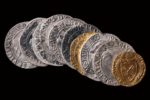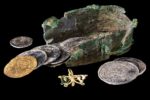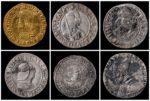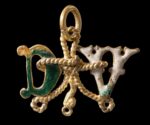 A hoard of coins from the late 15th century has been unearthed in downtown Dijon. National Institute for Preventive Archaeological Research (INRAP) archaeologists were surveying a site near Saint Bégnine Abbey when they discovered 34 gold and silver coins buried in the remains of a stone house. The house was built in the late 15th or early 16th century and the coins were cached under the floor near a wall.
A hoard of coins from the late 15th century has been unearthed in downtown Dijon. National Institute for Preventive Archaeological Research (INRAP) archaeologists were surveying a site near Saint Bégnine Abbey when they discovered 34 gold and silver coins buried in the remains of a stone house. The house was built in the late 15th or early 16th century and the coins were cached under the floor near a wall.
 Of the 34 coins, 10 are gold, 24 silver. They were put in a small bronze box, now surviving only in part due to damaged by development in the 20th century. Also included in the box was a green and white enamelled gold pendant. Corrosion had clumped the coins together into a single group.
Of the 34 coins, 10 are gold, 24 silver. They were put in a small bronze box, now surviving only in part due to damaged by development in the 20th century. Also included in the box was a green and white enamelled gold pendant. Corrosion had clumped the coins together into a single group.
 INRAP conservators were able to separate and clean them in the laboratory. They found that all the coins date to the second half of the 15th century and were issued from states in Italy (Papal States, Ferrara, Milan, Venice) and the Holy Roman Empire (Brabant, Savoy, the Palatinate). The oldest is a gold coin issued by Brabant between 1432 and 1467. The newest is a gold coin issued by Pope Innocent VIII (r. 1484-1492). Their condition suggests they were stashed before seeing much of any circulation.
INRAP conservators were able to separate and clean them in the laboratory. They found that all the coins date to the second half of the 15th century and were issued from states in Italy (Papal States, Ferrara, Milan, Venice) and the Holy Roman Empire (Brabant, Savoy, the Palatinate). The oldest is a gold coin issued by Brabant between 1432 and 1467. The newest is a gold coin issued by Pope Innocent VIII (r. 1484-1492). Their condition suggests they were stashed before seeing much of any circulation.
There is only one French coin, issued by King Louis XI. Italian coins dominate, with silver testones issued by the Sforza in Milan the best represented.
This deposit is of great numismatic interest. Very few examples of some of these coins are known. They often testify, especially among the Italian princes, to a strong personalization of the iconography, inherited in part from the codes of the Roman Empire. This iconographic “revival” participates in the styles of the Italian Renaissance. These often heavy and high-quality coins show the power of these Lords and their motivation to make reference currencies.
Ercole II d’Este, Duke of Ferrara, Philip Ist of Palatinate, Pope Innocent VIII, Louis XI, the Doge Nicolo Tron, Philip the Good, Duc de Bourgogne, etc… This deposit resembles a catalog of the great princes of the late Middle Ages.
This set of coins also constitutes a precious testimony of the frequentation of the area at the end of the 15th century. The origins of the coins, the relative richness of the lot — perhaps the savings of a family gradually acquired over fifteen or so years — reflects the social market sphere and the European trading world. The issuing locations cover regions that played a major role in the European trade of the time or were in connection with the Burgundy world (Brabant, Northern Italy, etc.).
 The pendant is a wedding medallion. It had two initials (a V and a C) connected by a golden cord. This was a popular type in the late Middle Ages and is common in wedding portraiture. It’s a handsome piece, but not made of the kind of expensive materials seen in aristocratic courts. It suggests the owners of the hoard were wealthy but did not mix in the highest ranks of the elite. They could have been petty nobility or members of the increasingly moneyed bourgeoisie.
The pendant is a wedding medallion. It had two initials (a V and a C) connected by a golden cord. This was a popular type in the late Middle Ages and is common in wedding portraiture. It’s a handsome piece, but not made of the kind of expensive materials seen in aristocratic courts. It suggests the owners of the hoard were wealthy but did not mix in the highest ranks of the elite. They could have been petty nobility or members of the increasingly moneyed bourgeoisie.
The precise circumstances of the deposit remain uncertain, but this handful of coins reflects the end of the century in Dijon with the fall of Charles the Bold, the annexation of the Duchy of Burgundy, the arrival of the troops of the King of France in the walls of Dijon while beyond the Alps, the sounds of the wars of Italy are heard.